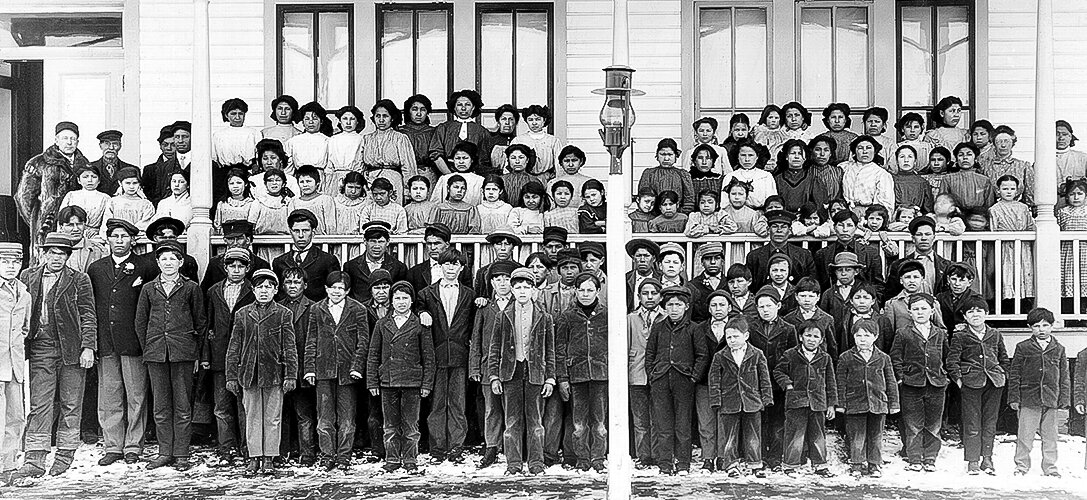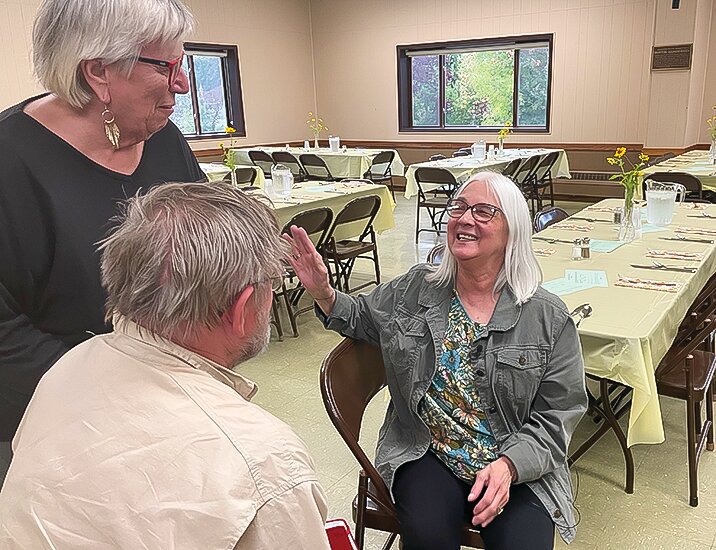Support the Timberjay by making a donation.
The school across the bay
Grover assesses the complicated history of the Vermilion Lake Indian School
TOWER- For many Native American tribes, including the Ojibwe, educating their children in their traditional ways kept their culture intact. Which is why the movement to remove Indian children to boarding schools to teach them the ways of Europeans was so culturally devastating.
That’s according to historian Linda LeGarde Grover, who keynoted the Tower-Soudan Historical Society’s annual dinner here last week.
Grover said the so-called boarding school movement began with the Carlisle Indian School in Pennsylvania, which opened right after the Civil War. But it soon spread around the country, including to the North Country. The Vermilion Lake Indian School, located on Sucker Point, where the Bois Forte offices and health facilities are found today, opened in 1899 and ran through 1953. Its history is personal to Grover, a retired professor of Indian Studies at University of Minnesota- Duluth, whose grandparents met at the school.
“My aunt told me if it wasn’t for the school, I wouldn’t be here,” said Grover.
As Bois Forte band members, Grover’s family lived on the Vermilion Reservation. Today, she is known for her poetry, fiction, and nonfiction, and has won many literary awards.
While children were not forced to go to attend the boarding school, most families sent their children because it meant they would get new clothes and be fed regularly. “Life was very hard at home,” she said. “Parents could take a little comfort that their kids were being fed and clothed.”
Children had to live at the school during the school year and were not allowed to see their families. This was unusually harsh since most of the children enrolled at the school were from the Vermilion Reservation, whose parents often lived nearby. If lonely parents tried peaking through the school’s windows to catch glimpses of their children, the teachers would pull the shades, ostensibly to keep from upsetting the children.
This was less an issue at most other boarding schools in the state, which housed students from a wide area and often many different states.
Children at Vermilion wore uniforms. The boys’ uniforms were shipped in, but the girls, Grover said, sewed their own uniform dresses from bolts of fabric the school received. Sewing and other household skills were an integral part of the educational program for girls, while boys were taught farming and worked in a sawmill on the grounds.
Students stayed at the Vermilion school until they were 16 or 17, but they only got the equivalent of a sixth-grade education. Older students were also tasked with caring for the youngest students, some of whom were preschoolers.
“They often didn’t have the best teachers,” Grover said. “The emphasis was not on academics, but on assimilation.” Students were forced to speak in English and go to church. Boys’ hair, traditionally kept long at home, was cut short. “Physical punishment was expected and could be very harsh,” Grover said. There were reports of deaths at the school.
“Children were hurt badly at times,” she said. “There were children who died in accidents or mysterious circumstances. One of my relatives is buried on the grounds somewhere there,” she said.
Girls’ hair was also cut, often into a pixie style. Grover’s grandmother talked about how she often was punished for things she didn’t do.
“The girls all had the same haircuts and glasses,” she said, noting the teachers really weren’t able to tell them apart. “She finally went to the school superintendent and told him if the only thing I am doing here is scrubbing those stairs, I might as well go home.”
“She was a very mild lady,” Grover said of her grandmother. “I can’t imagine her disobeying anyone.”
The federal government had mandated that Indian children be educated, and parents could be imprisoned if they didn’t send their kids to school. In many cases, there were no alternatives to a boarding school, she said, because of the condition of area roads, which made getting a child to and from school in a nearby town almost impossible.
Grover said many of her relatives were reluctant to talk about their time at these boarding schools. Many students tried to run away, but they were usually found right away. She said her uncle ran away from an Indian boarding school in Hayward, Wis., and when he got himself back to his home in Duluth, someone was already waiting to bring him back. The runaways were usually easy to find, Grover said, because they were heading to their homes.
“My mother told me not to ask him about it, because it made him too sad,” Grover said.
Grover had relatives who attended similar schools around the state and in Wisconsin.
Boarding schools began to be dismantled in the 1930s, she said. “A study showed how the schools were hurting children.”
While the public was shocked at the treatment given to Native students at these schools, Grover said she was just used to it. “It has been harder and harder for me to do this research,” she noted. “But I feel like I must do this.”
Besides the impact on the children taken away, she said there was additional trauma on the families left behind. “What was it like to live in a community with no children,” she wondered aloud.
After the Spanish flu epidemic, which forced the Vermilion school to close for a period of time between 1919 and 1921, enrollment at the school dwindled, with some students traveling to school in Tower and Soudan.
Martha Martilla, who later ran the drugstore in Tower with her brother Walter, taught at the school during the period after the Spanish flu. By this point, the school no longer was a boarding school, and just served about two dozen students in grades K-6, who lived on the reservation. Walter drove Martha back and forth each day. At first the roads were awful, Grover said, but soon a passable gravel road was in place. Also, at that time, the school curriculum matched that at the elementary schools in Tower and Soudan. When the school closed, Martha taught in Soudan, and worked with many of the same students she had at Vermilion. The closure was the result of a state policy to eliminate small, segregated schools that mostly served Indians. This was concurrent with a federal policy that aimed to disband tribes and strip them of their federal designation. Though the Minnesota Chippewa Tribe was never disbanded, 61 other tribes across the country were terminated. Grover writes in her article (see link below) that this policy was another attempt at assimilation, intended to get people to leave their reservations and live in cities.
The damage done to generations of children and families is unspeakable, she said. “There is no way to reconcile this,” she said. “They were trying to destroy a people…But we are still here.”
Grover has collected photographs of the school for years. The schools were mindful of their public relations, and photos of well-clothed students standing in front of nice-looking school buildings were popular, and often made into postcards.
One family photo she treasures is of her uncle as a teenager, standing next to his best friend, who still has family members living on the Vermilion Reservation.
“When I was a professor at UMD, a new professor was hired. It turned out he was a descendent of my uncle’s friend from the photograph,” she said.
“We honor those who went through the experience, we remember and honor them. We want our children to succeed in school,” she said, ending her talk to a loud round of applause.
To learn more:
Find Grover’s article published by the Minnesota Historical Society, “ The Vermilion Lake Indian School: From Assimilation to Termination” here, https://bit.ly/3sH4dLG.
Some of the information above comes from this article.
The Bois Forte Heritage Center has a permanent exhibit on the school, which includes a replica of one of the classrooms. For more information, https://www.boisforteheritagecenter.com/.









